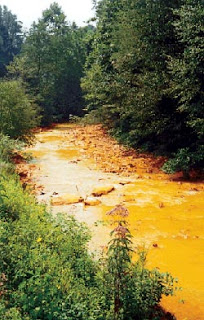 |
| example of acid mine drainage |
Debbie Coffey
PPJ Gazette
Nevada is one of the most seismically active states in the U.S.A., ranking third after California and Alaska. Nevada’s many faults are found at the base of almost every mountain range.
A proposed molybdenum mine at Mt. Hope, near Eureka, Nevada, (owned by General Moly) seems to be located near the Diamond Valley Fault zone, the Western Diamond Mountains Fault zone and the Diamond Mountains Fault zone.
On Feb. 21, 2008, a magnitude 6.0 earthquake shook Wells, Nevada and caused extensive building damage. This earthquake occurred on a previously unmapped fault.
The U.S. National Park Service states “While earthquakes don’t occur at any regular interval, historically the frequency of an earthquake of magnitude 6 or higher has been one every 10 years, and for magnitude 7 or higher, one every 27 years.”
Even the drilling from geothermal projects causes little earthquakes. A magnitude 4.5 was reported at The Geysers in Lake and Sonoma counties in California.
Could an earthquake cause Mt. Hope’s tailings pipeline to rupture, or damage buildings, equipment or the lining of the pit tailing pond?
Eureka Moly (a consolidated subsidiary of General Moly) sent brochures to Eureka residents declaring “A Eureka Moment! Eureka Moly will protect water resources in the region.”
How can Eureka Moly promise this?
Even without an earthquake, there are potential problems. In an article titled “False Promises: Water Quality Predictions Gone Wrong: Large Mines and Water Pollution” (Earthworks/MPC 2004) it states that “Water quality impacts from hard rock mines are very difficult to predict. Despite modern technology, government and industry predictions are often wrong, and the long term environmental and fiscal implications are often severe.”
The article gives ten examples, including Rain Gold Mine, near Elko, Nevada, “which has had a serious acid mine drainage problem since 1990, when surface water drainage from the mine’s waste piles began generating acid, contaminating two miles of nearby Dixie Creek. The drainage also contained elevated levels of mercury and arsenic.” Newmont mining, the mine’s owner, supposedly didn’t anticipate an acid mine drainage problem.
Another example is the Thompson Creek Molybdenum Mine in Idaho’s Salmon River Mountains. There were concerns because processed mine waste in the tailings contained pyrite, and earthquakes, landslides, erosion or water system failures could expose pyrite to air and water, causing Acid Mine Drainage (AMD) to form, sending acid and dissolved metals towards the Salmon River. The Forest Service knew there was AMD in 1988, and recommended that the mine needed to address AMD problems in 1989. The revised operating plan to address AMD wasn’t released until 1998. Nine years later.
Earthworks, a non-profit organization protecting communities and the environment from “the destructive impacts of mineral development,” describes acid mine drainage: “At metal mines, the target ore is often rich in sulfide minerals. When the mining process exposes the sulfides to water and air, together they form sulfuric acid. This acid can and does dissolve other harmful metals and metalloids (like arsenic) in the surrounding rock. Acid mine drainage can be released anywhere on the mine where sulfides are exposed to air and water, including waste rock piles, tailings, open pits, underground tunnels and leach pads.”
Also, acid mine drainage “can occur indefinitely – long after mining has ended. Many hardrock mines across the western United States may require water treatment in perpetuity.”
RELATED ARTICLES:
Chinese Government Money Is Buying One of USA’s Biggest Mines
10 Reasons Our Shallow Fresh Water Supply is in Deep Trouble


Be the first to comment on "General Moly’s Mt. Hope mine: let’s hope the “Eureka moment” doesn’t spell disaster"